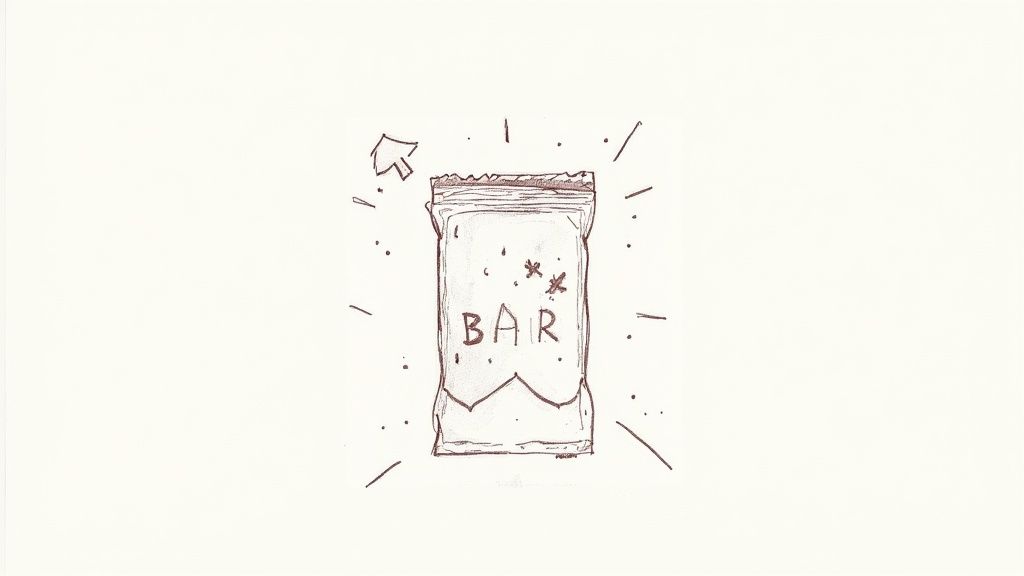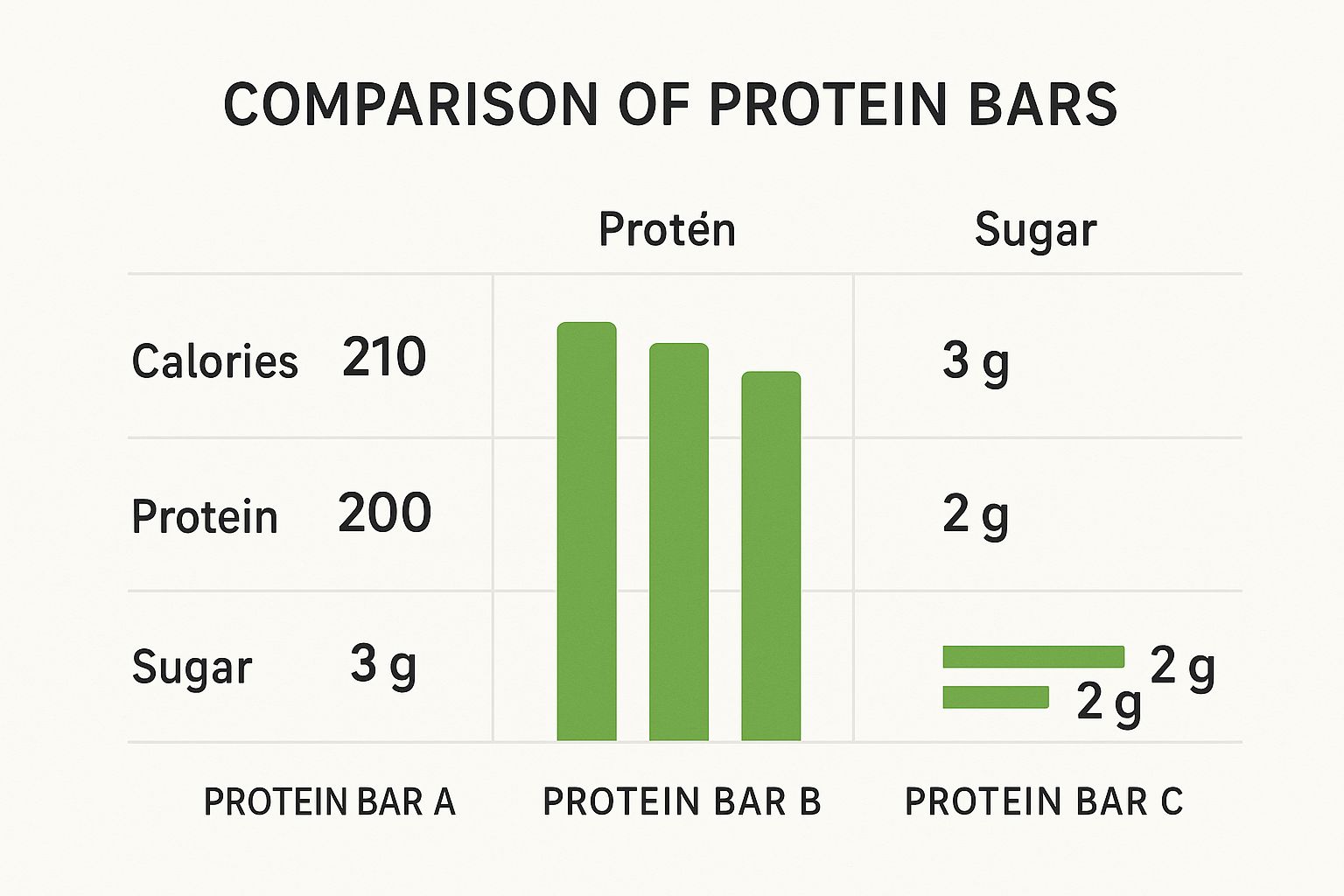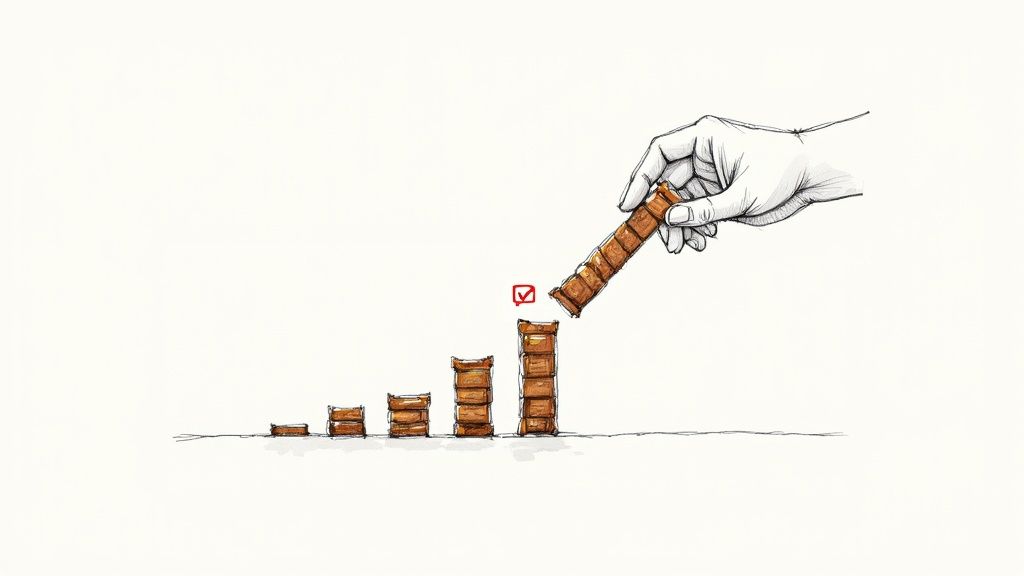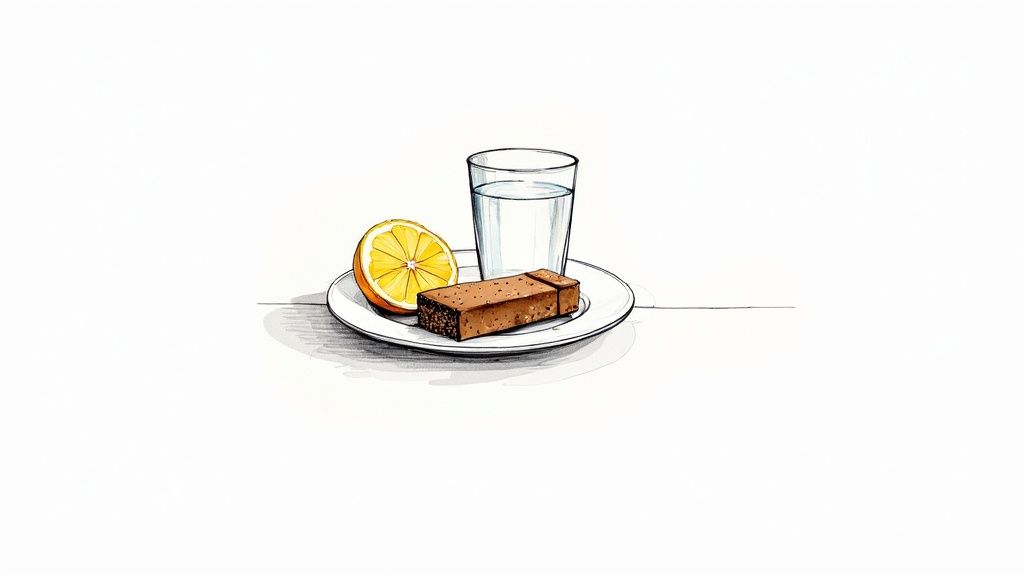Let’s be honest, trying to find a protein bar that actually helps with weight loss can feel like a full-time job. Most of them are just candy bars in disguise. But if you know what to look for, you can cut through the noise.
My rule of thumb is simple: I look for high protein (at least 15g), a good dose of fiber (I aim for 5g or more), and very low sugar (definitely under 5g). These three numbers are your secret weapon for quickly spotting the good ones and leaving the junk on the shelf.
Why a Good Protein Bar Is Your Secret Weapon for Weight Loss
First, let's get one thing straight: not all protein bars are your friends. A lot of them are loaded with enough sugar, fat, and questionable ingredients to completely sabotage your progress. But the right bar? That's a different story. It can be a game-changer when you're busy and need something that works for you, not against you.
The key is to think of it as a small, strategic meal, not a treat.
It’s the convenience that really makes them shine. When you're stuck in traffic or running between meetings and hunger hits, a good protein bar is the perfect backup plan. Keeping one in your gym bag, car, or desk drawer can save you from a desperate trip to the vending machine or drive-thru.
The market for these things has exploded. It was valued at nearly USD 14.98 billion in 2024, and it's only getting bigger as more people look for healthy, low-sugar, and even plant-based snacks. You can read more about protein bar market trends to see just how much focus is shifting toward bars designed for weight management. For us, that’s great news—it means more quality options to choose from than ever before.
A truly effective weight loss protein bar does more than just give you a protein boost. It should crush your hunger, keep your energy steady, and deliver real nutrition without costing you a ton of calories. It’s a strategic choice, not just a random snack.
So, how do you pick a winner? It's all about what the bar can do for you. A genuinely helpful bar will:
- Keep You Full for Hours: Protein is the king of satiety. It makes you feel full and satisfied, which is critical for preventing overeating later in the day.
- Protect Your Muscle: When you're eating in a calorie deficit to lose fat, getting enough protein helps you hold onto your lean muscle. You want to lose fat, not muscle.
- Tame Your Cravings: A bar that’s high in protein and low in sugar helps stabilize your blood sugar. No more energy crashes that send you running for cookies or chips.
This guide is designed to give you a simple, no-nonsense system. We’re going to ignore the flashy marketing on the front of the wrapper and get straight to what matters: the nutrition label. Once you know what to look for, you'll be able to walk into any store and confidently choose the top protein bars for weight loss that fit your goals perfectly.
Quick Guide to Weight Loss Friendly Protein Bars
To make it even easier, here's a quick cheat sheet with the ideal numbers to look for. Think of this table as your go-to reference when you're standing in the snack aisle, trying to make a smart choice.
| Nutrient | Ideal Range Per Bar | Why It Matters for Weight Loss |
|---|---|---|
| Protein | 15-25g | The most filling macronutrient; helps preserve muscle mass. |
| Calories | Under 250 | Keeps the bar a "snack" and not a full meal replacement. |
| Net Carbs | Under 15g | Minimizes blood sugar spikes and subsequent crashes. |
| Fiber | 5g or more | Aids digestion and significantly increases feelings of fullness. |
| Total Sugar | Under 5g | Avoids empty calories and prevents cravings caused by sugar highs. |
Sticking to these targets is the fastest way to filter out the duds and find a protein bar that will genuinely support your weight loss journey.
Decoding the Nutrition Label for Fat Loss

The front of the wrapper is pure marketing. The real story is on the back. Learning to quickly scan the nutrition label is probably the single best skill you can develop to find a protein bar that actually helps with weight loss. This is where you cut through the hype and look at the hard data.
Don't let all the numbers intimidate you. You really only need to zero in on a few key areas to figure out if a bar is a smart choice or just a candy bar in a clever disguise. Once you get the hang of it, you'll be able to size up a label in seconds.
First Things First: Check the Protein-to-Calorie Ratio
Before you look at anything else, see how much protein you’re getting for the calories. This ratio is the biggest indicator of how full that bar is going to keep you.
Think about it: a bar with 200 calories but only 10 grams of protein is a pretty bad deal. It won’t do much to curb your hunger and eats up a good portion of your daily calorie goal.
Now, a bar with 200 calories and 20 grams of protein? That's a winner. It tells you the bar is protein-dense and built for satiety. A solid rule of thumb I always use is to look for at least 10 grams of protein for every 100 calories.
A high protein-to-calorie ratio is your best guarantee that a snack is actually working for you, not against you. This quick check helps you sidestep those impostor bars that are mostly just carbs and fat.
If you're ever fuzzy on how a particular snack fits into your bigger picture, using a tool to see the full nutritional breakdown can be a game-changer. You can get a much clearer view of your daily intake by using a recipe calorie calculator to understand how your meals and snacks add up.
Master the Carbohydrate Section
Next, your eyes should jump to the carbohydrates. This part can feel a bit tricky because not all carbs are the same. You need to look past the "Total Carbohydrates" and inspect two specific lines: fiber and sugar.
Here’s what to look for:
- Dietary Fiber: I never pick a bar with less than 5 grams of fiber. Fiber is a powerhouse for feeling full because it slows down digestion and helps keep your blood sugar stable. It's a non-negotiable for any weight-loss-friendly bar.
- Total Sugars: Keep this number as low as you can find, ideally under 5 grams. Anything higher is going to give you that classic energy spike and crash, which just leaves you hungry for more sweets later.
Focusing on high fiber and low sugar ensures the bar provides steady, sustained energy, not a short-lived rush.
A Quick Look at Net Carbs
For fat loss, "net carbs" are what really count. This is the amount of carbohydrate your body actually breaks down and uses for energy. The calculation is surprisingly simple.
The Formula: Total Carbohydrates - Dietary Fiber = Net Carbs
Let's say you pick up a bar with 20 grams of total carbs and 8 grams of dietary fiber. The net carbs would be just 12 grams (20 - 8 = 12). When you're trying to lose weight, aiming for a bar with under 15 grams of net carbs is a great way to avoid those blood sugar spikes that can sabotage your progress.
What’s Really Inside Your Protein Bar?
Macros tell you part of the story, but the ingredient list reveals the truth about a protein bar's quality. A top-tier bar is built on a foundation of solid, high-quality ingredients. A bad one? It's often just a candy bar in a clever disguise, packed with fillers and sweeteners. Learning to spot the difference is crucial.
The protein source itself is a huge factor in how full you'll feel. Whey and casein, both dairy-based, are fantastic because they have complete amino acid profiles and digest slowly, which is great for keeping hunger at bay. If you're going plant-based, look for bars with a blend of sources, like pea and brown rice protein, to get a more complete profile that delivers similar benefits.
This infographic breaks down the nutrition facts for a few popular bars, giving you a clear visual of what a good choice looks like.

It’s pretty clear, right? The bars with more protein and less sugar pack a much better nutritional punch for the calories.
The Sweetener Trap
One of the biggest pitfalls with protein bars is the sweetener situation. Many bars boast about being "low sugar," but they often achieve this by loading up on artificial sweeteners and sugar alcohols, which can be a nightmare for your digestive system.
Natural sweeteners like stevia or monk fruit are generally a better bet, but you still have to watch out for sugar alcohols like erythritol, sorbitol, and maltitol. For some people, these can cause serious bloating and discomfort. Also, keep an eye out for hidden sugars masquerading under names like brown rice syrup, tapioca syrup, or cane juice.
The ingredient list is non-negotiable. Look for whole-food ingredients you recognize—like nuts, seeds, and real protein sources—at the top of the list. The fewer artificial fillers, syrups, and unpronounceable chemicals, the better the bar is for your body and your weight loss goals.
Whole Foods Over Artificial Fillers
At the end of the day, a good protein bar should be made from ingredients that offer real nutritional value. When you scan the label and see a long list of artificial fillers, strange-sounding fibers, and chemical binders, it's a dead giveaway that the bar is highly processed and lacking substance.
Navigating the ingredient list can feel overwhelming, so I've put together a simple table to help you quickly identify the good guys and the bad guys.
Good vs. Bad Ingredients in Protein Bars
| Ingredient Category | Look For These (Green Flags) | Avoid These (Red Flags) |
|---|---|---|
| Protein Sources | Whey isolate/concentrate, Casein, Egg white protein, Pea protein, Brown rice protein, Hemp protein | Soy protein isolate, Collagen (unless it's a secondary source), Gelatin |
| Sweeteners | Stevia, Monk fruit, Allulose, Dates (in small amounts) | High fructose corn syrup, Sucralose, Aspartame, Maltitol, Sorbitol, Brown rice syrup |
| Fats & Binders | Nut butters (almond, cashew), Nuts, Seeds (chia, flax, pumpkin), Coconut oil, Cacao butter | Palm oil, Hydrogenated oils, Fractionated palm kernel oil, Soy lecithin (if in high amounts) |
| Fiber Sources | Soluble corn fiber, Chicory root fiber, Inulin, Acacia gum, Whole foods like nuts & seeds | Corn husk, Polydextrose, Cellulose gum (often a sign of a highly processed bar) |
| Carbohydrates | Rolled oats, Quinoa, Buckwheat, Fruit (in small amounts) | Refined flours, Tapioca starch, Cane juice, Maltodextrin |
Think of this as your cheat sheet. The more ingredients you see from the "Green Flags" column, especially near the top of the list, the better your choice will be.
Luckily, people are getting smarter about what they eat, and manufacturers are starting to listen. It turns out 40% of potential buyers are now actively avoiding bars with high sugar content. This shift has led to a boom in healthier options, with low-sugar and plant-based bars now making up 35% of new products hitting the shelves.
If you're looking for ideas on how to use clean ingredients you probably already have, check out our guide on cooking with what's in your pantry. By choosing bars with simple, recognizable ingredients, you’re making sure your snack is actually helping you, not holding you back.
How to Use Protein Bars in Your Diet Plan

Finding the right protein bar is only half the battle. The real secret is knowing how and when to use it. A good protein bar can be an incredible asset, but if you treat it like a candy bar, you'll undo all your hard work.
Think of it as a nutritional safety net, not a daily indulgence. Mindlessly unwrapping one out of boredom or habit can easily pile on hundreds of extra calories. The key is to be intentional.
The Best Times to Grab a Bar
Timing is everything. A protein bar can either be a smart move that supports your goals or a snack that slows you down. Instead of eating them randomly, plan to use them when they give you the most bang for your buck.
Here are a few moments when a protein bar is your best friend:
- Right After a Workout: Your muscles are screaming for nutrients to repair and rebuild. A bar with 20-25 grams of protein is perfect for kickstarting that recovery process. This helps you hold onto precious lean muscle, which keeps your metabolism firing on all cylinders.
- The Mid-Afternoon Slump: You know that 3 p.m. feeling when your energy crashes and you start craving sugar? A protein bar is the perfect antidote. It’ll satisfy that craving and keep you feeling full until dinner, so you don't overeat later in the evening.
- The "No Time for a Real Meal" Emergency: We’ve all been there—stuck in meetings, running errands, or just having a chaotic day. A protein bar is a far better choice than skipping a meal entirely or caving for fast food. It gives you the balanced energy you need to keep going.
Common Mistakes to Avoid
Even the "healthiest" protein bar can work against you if you're not careful. The biggest mistake I see people make is relying on them as a full meal replacement every single day.
They're fantastic in a pinch, sure, but they just can't compete with the vitamins, minerals, and sheer volume of a real meal made from whole foods.
A protein bar should be your Plan B, not your Plan A. It's a strategic supplement to a diet rich in whole foods, designed to fill nutritional gaps when life gets hectic.
Another common pitfall is forgetting to actually track the bar. The calories and macros count! If you’re logging your food, make sure the bar gets added to your daily total. Those calories can add up faster than you think. If you’re getting into making your own bars or snacks, a cups to grams converter can be a lifesaver for keeping your measurements on point.
The market for these "pro-diet" bars is booming, projected to jump from USD 7.3 billion in 2024 to USD 18.0 billion by 2034. It's clear people love the convenience for weight management. You can see the full pro-diet bar market insights to understand the trends. Just remember to use them wisely—as a planned tool, not a mindless treat—and they’ll help you stay on track.
Common Mistakes to Sidestep When Picking a Protein Bar
Let's be real: the protein bar aisle is a confusing place. With so much flashy packaging and loud health claims, it's way too easy to grab something that actually works against your weight loss goals. The biggest trap? The "health halo."
Marketers are experts at using buzzwords to make a bar seem healthier than it is. Just because a label screams "natural," "keto-friendly," or "plant-based" doesn't automatically mean it's a smart choice. A "keto" bar can easily pack 300+ calories, and a "natural" bar might be loaded with fruit syrups that send its sugar content through the roof.
My rule of thumb is simple: ignore the front of the package. It's pure marketing. Flip it over and get friendly with the nutrition label—that's where the truth is.
Forgetting That Calories Still Count
It’s a classic mistake: you grab a bar for a "light snack" without checking the calorie count. The problem is, some bars are small snacks, while others are basically a full meal in a wrapper. It's surprisingly easy to unknowingly scarf down 350-400 calories, which can quietly sabotage the calorie deficit you've worked so hard to maintain.
Before you commit, look at the total calories. Ask yourself if it fits your plan as a quick bite or if it needs to be treated as a more substantial part of a meal.
The real secret to finding a great bar is checking its protein-to-calorie ratio. If you're spending 300 calories to get just 15 grams of protein, that's not a great deal. A good benchmark to aim for is at least 10 grams of protein for every 100 calories.
Ignoring Ingredients That Wreck Your Gut
We often get so hyper-focused on macros that we completely forget to scan the ingredient list for things that can cause digestive chaos. Sugar alcohols are a huge one. Be on the lookout for names like erythritol, sorbitol, and maltitol. While they slash the sugar content, they're notorious for causing bloating, gas, and stomach cramps in a lot of people.
It’s the same story with certain processed fibers. Your body might not be prepared to handle them in such concentrated doses. If you find yourself feeling off after eating a particular bar, your gut is trying to tell you something. Check the ingredients for those common culprits and find an alternative that sits better with you. A snack is supposed to make you feel good, not miserable.
Finally, a word of caution: don't let bars become your go-to food source. They are an incredible tool for convenience—perfect for those "uh-oh, I'm starving" moments or a quick post-workout refuel. But they can't replace the vast array of vitamins, minerals, and nutrients you get from whole foods. Think of them as a backup plan, not your primary nutrition strategy.
Your Protein Bar Questions Answered

When you're standing in front of that massive wall of protein bars, it's easy to get overwhelmed. The claims, the flavors, the sheer number of choices—it’s a lot. Let's tackle some of the most common questions I hear so you can grab the right bar with confidence.
A big one is whether a protein bar can actually replace a meal. My take? They’re a fantastic backup plan, but not a daily substitute for real food. A proper meal gives you a wide array of vitamins, minerals, and other micronutrients that a processed bar just can’t match.
Think of them as a pinch-hitter, not your starting player. Using one when you’re stuck in traffic or running between meetings is perfectly fine. But relying on them day in and day out isn't a great long-term strategy for staying full and nourished.
Can I Eat a Protein Bar Every Day for Weight Loss?
Absolutely, as long as you're strategic about it. A daily bar can be a smart move if it's a planned part of your day, like a post-workout refuel or a way to crush those 3 p.m. cravings. The trick is to make sure it fits neatly into your calorie and macro targets.
Where people run into trouble is mindless snacking. Grabbing a bar out of habit or boredom can tack on an extra 200-250 calories a day, which can definitely stall your progress if you aren't accounting for it.
Consistency beats perfection every time. If a daily protein bar keeps you from grabbing a donut from the breakroom, that's a huge win. Just make it a conscious choice, not an afterthought.
What About Plant-Based Protein Bars?
Plant-based bars can be fantastic for weight loss! They’re often packed with fiber from sources like nuts, seeds, and legumes, which does wonders for keeping you full. All the same rules apply here: flip it over and check the protein, sugar, and total calories.
Just keep an eye out, as some plant-based options can be a little lower in protein or higher in carbs than those made with whey. I often look for bars that use a blend of proteins, like pea and brown rice, to get a more complete range of amino acids.
Here are a couple of final things I always tell my clients:
- Dealing with Bloating: If a certain bar leaves you feeling gassy or bloated, it's probably the sugar alcohols (like erythritol or maltitol) or a specific type of fiber. Your gut might just not be a fan of those ingredients, so try a different bar.
- Taste Is Everything: Don't force yourself to eat something you hate. What your gym buddy loves might taste like chalk to you. Sample a few different brands and flavors until you find one you actually look forward to eating. It makes sticking with your plan so much easier.
Ultimately, the "best" bar is the one that fits your body, your lifestyle, and your taste buds.
Ready to get your recipes organized so you can focus on your health goals? Recipe One makes it easy. With our AI-powered tool, you can instantly save recipes from anywhere online into a clean, searchable format. Stop wasting time and start building your perfect meal plan. Discover how Recipe One can simplify your kitchen today!

